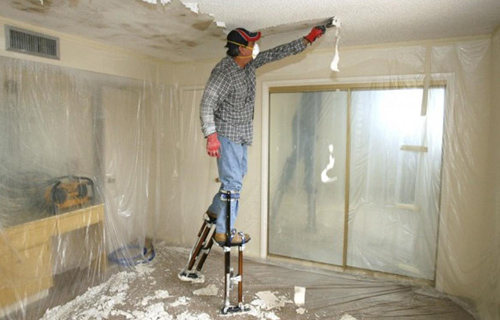Asbestos Popcorn Ceiling - a DIY Remodelling

Records show that each year in the United States asbestos claims the lives of about 15,000 people. The high toxicity of the mineral is hardly news to anyone anymore. Its devastating effects have been a matter of public concern beginning with the late 1970s when measures to regulate the use of the material started being implemented as a response to the fibers having been linked by medical experts to various cancerous illnesses, including something as unforgiving as mesothelioma.
Although most of the talk has been about people developing asbestos-related diseases as a result of their occupation, the attention soon shifted toward thousands of families suspected of living with the toxin under their roof as a consequence of the fact that before the 1980s, the majority of the houses in the U.S. were built with materials containing asbestos.
The Issue with Asbestos in Your Home
The issue with asbestos in the home can be a tricky one, but the thing to remember is that the mineral only becomes a threat to the health of those in its presence when it is in its fiber form. Otherwise, when left undisturbed in whatever compound it belongs to, the substance is harmless.
One of the biggest fears of the American homeowner is that the so-called popcorn ceiling in their house might contain asbestos. In fact, when it comes to a DIY kind of abatement in one of three cases, the purpose is to get rid of popcorn ceiling. It should be noted, however, that not all popcorn ceilings have asbestos in them since the Environmental Protection Agency (EPA) has implemented rules focused on asbestos usage beginning with the 1970s, with a full ban on using asbestos in ceiling paint occurring in 1977.
What to Do with the Popcorn Ceiling in Your House
To know whether there is asbestos in your popcorn ceiling or not, you have two viable options:
- look into a test kit that you could buy.
- take your worries to an asbestos abatement expert.
Any other method you're thinking of is probably not worth your safety. You have to keep in mind that popcorn ceiling, unlike other asbestos items is a bit more delicate to handle because of the crumbliness aspect of it.
However, if your ceiling is deteriorated, then getting rid of it is the only solution. The ideal approach would be to leave the issue in the hands of asbestos professionals so that your good intentions to protect yourself and your family don't end up being counterproductive. You cannot simply get some tools and start your renovation project. You first need to be serious about your knowledge in dealing with hazardous substances. In many cases, such as commercial buildings and multifamily buildings a DIY project involving asbestos is illegal. Single-family homes, however, are not prohibited by law to take such action.
Living with an Asbestos Popcorn Ceiling
Before taking the chance of scraping at a popcorn ceiling that potentially contains asbestos, consider that you can safely live in the house as long as you:
- do not perforate the ceiling with nails or screws.
- do not install high shelves to hold objects that might disturb the ceiling.
- keep a watch on children throwing toys at the ceiling scraping it.
The Struggles of an Asbestos DIY Project
When there is asbestos involved, a do-it-yourself project is not the ideal route, since the work required of you might turn out more challenging and dangerous than you anticipated. Because of the lack of training in such a field, here are a few difficulties you may encounter:
- having trouble breathing - not using respirators routinely might take a toll on you.
- being uncomfortable in the protective gear - it may be too hot, too heavy and it could distract you from the task.
- having impaired visibility - just like the rest of the gear, it takes time to be able to master eyewear.
If despite all the information you gather you decide to still go through with the plan, then you should make sure that you follow elementary safety measures, such as:
- removing the furniture from the work site;
- sealing windows and doors;
- purchasing a high-quality respirator;
- wearing disposable coveralls;
- dampening the ceiling to prevent dust;
- placing the waste in sealed and labeled plastic bags;
- calling an authorized asbestos disposal site.
